



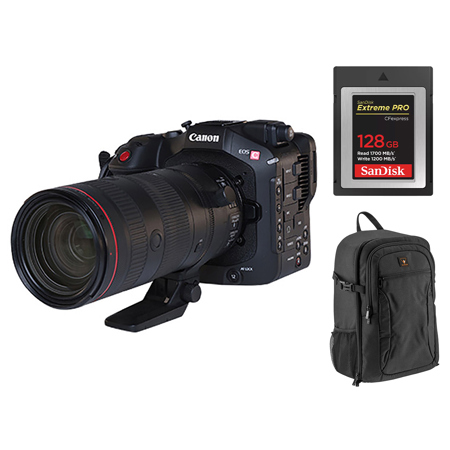
PACKAGE INCLUDES:



Note: 1 or more items are unavailable for immediate shipping
See Options
Need help? Ask our experts.
Review Summary
Accidents happen where life happens. Protect your favorite Adorama products and purchase a protection plan to stay covered from accidental damage, mechanical or electrical failure, and more.
If we can’t fix it, we’ll replace it at no additional cost.
Protect your product from drops, spills, and more.
Enjoy your gear without fear. We have you covered!
When regular use of your product over time results in mechanical or electrical failure.
We will never charge you a deductible after the purchase of a plan.
Our claims process is simple & easy and our customer service team is happy to help.
Adorama Protect powered by Extend is available for purchase to customers in the United States. Not available for purchase Internationally or in U.S. Territories.
Browse our FAQ

CarePAK PLUS provided through Canon offers protection from accidental damage such as drops, spills, power surges, and more including normal wear and tear, beyond the standard warranty period.
Canon RF mount
RF lens (including RF-S lens, RF cinema lens), EF lens (including EF lens, EF cinema lens (when equipped the RF-EF mount Adapter, sold separately) PL lens (when equipped the Mount Adapter PL-RF, sold separately)
Cooke Communication Protocol: Only when equipped with Mount Adapter PL-RF.
Color wide LCD monitor
3.5" (8.8cm)
Approx. 2.76 million dots (1280 x RGB x 720)
100%
Brightness, Contrast, Color, Sharpness, Luminance
Electrostatic capacitance system. Touch/drag operation supported.
Full-Frame back-illuminated stacked CMOS sensor
Full-Frame, Super 35mm (Crop)
Approx. 26.67 megapixels (6202 x 4300)
Sensor mode: Full frame:
Approx. 1904.5 MP (6008x3170): When 6000x3164 / 4096x2160 / 2048x1080 is selected as the resolution
Approx. 1786.0 MP (5634x3170): When 3840x2160 / 1920x1080 is selected as the resolution
Sensor mode: Super 35mm (Crop):
Approx. 1010.9 MP (4376x2310): When 4368x2304 / 4096x2160 / 2048x1080 is selected as the resolution
Approx. 948.0 MP (4104x2310) : When 3840x2160 / 1920x1080 is selected as the resolution
6.0 x 6.0 (microm)
Sensor mode: Full-Frame
36.0 x 19.0mm (40.7mm on the diagonal)
When 6000x3164 / 4096x2160 / 2048x1080 is selected as the resolution
33.8 x 19.0mm (38.7mm on the diagonal)
When 3840x2160 / 1920x1080 is selected as the resolution
Sensor mode: Super 35mm (Crop)
26.2 x 13.8mm (29.6mm on the diagonal)
When 4368x2304 / 4096x2160 / 2048x1080 is selected as the resolution
24.6 x 13.8mm (28.2mm on the diagonal)
When 3840x2160 / 1920x1080 is selected as the resolution
RGB primary color filter (Bayer array)
Both are measured values of output signals. The measurement method is based on ARIB TR-B45.
- 59.94 Hz mode: 67 dB (Typical)
Full frame: 3840x2160 / 29.97P, BT.709 Standard Base Sensitivity ISO 160 (Dynamic range 300%)
- 50.00 Hz mode: 67 dB (Typical)
Full frame: 3840x2160 / 25.00P, BT.709 Standard Base Sensitivity ISO 160 (Dynamic range 300%)
Canon Log 2: 1600% / 16 stops (at Base Sensitivity ISO 800)
Canon Log 3: 1600% / 14 stops (at Base Sensitivity ISO 800)
59.94 Hz: f/10 (59.94P) / f/14 (29.97P)
50.00 Hz: f/11 (50.00P) / f/16 (25.00P)
All values for ISO 800,2000 lux, and reflectance rate of 89.9%. Some lens specifications may not enable these f-numbers.
Full-Frame:
RAW: XF-AVC, XF-AVC S, XF-HEVC S
Super 35mm (Crop):
RAW: XF-AVC, XF-AVC S, XF-HEVC S
Full-Frame:
6000x3164
4096x2160, 3840x2160, 2048x1080, 1920x1080
Super 35mm (Crop):
4368x2304
4096x2160, 3840x2160, 2048x1080, 1920x1080
RAW
XF-AVC
XF-AVC S
XF- HEVC S
RAW: Cinema RAW Light (Canon original)
XF-AVC: MPEG-4 AVC/H.264
XF-AVC S: MPEG-4 AVC/H.264
XF- HEVC S: HEVC/H.265
RAW/XF-AVC: Linear PCM (24 bit 48kHz) 4 channels
XF-AVC S/XF- HEVC S: MPEG2-AAC LC (16 bit 48kHz) 2 channels
Linear PCM (24 bit 48kHz) 4 channels
Full-Frame
RAW:
Photo Resolution: 4096x2160
XF-AVC, XF-AVC S / XF-HEVC S:
Main Resolution: 4096x2160, 2048x1080, 3840x2160, 1920x1080
Photo Resolution: 4096x2160, 3840x2160
Super 35mm (Crop)
RAW:
Photo Resolution: 4096x2160
XF-AVC, XF-AVC S / XF-HEVC S:
Main Resolution: 4096x2160, 2048x1080, 3840x2160, 1920x1080
Photo Resolution: 4096x2160, 3840x2160
SD Card
2
SD, SDHC, SDXC
Speed class: C6, C10 UHS speed class: U1,U3 Video speed class: V30, V60, V90
SD card (2GB) : FAT12,16
SDHC card (up to 32GB): FAT32
SDXC card (32GB to 2TB): exFAT File division units: FAT32 is 4GB, exFAT is none Maximum of 999 file divisions per clip (FAT32 only)
999
In addition to proxy recording and photos, recording of custom pictures, metadata, and menus, etc., is also possible
Frame rate: Available frame rate for Slow & Fast Motion Recording:
59.94P: 1, 2, 3, 6, 15, 30, 44, 48, 52, 56, 60, 90, 120, 150, 180
29.97P: 1, 2, 3, 6, 15, 22, 24, 26, 28, 30, 32, 36, 40, 44, 48, 52, 56, 60, 90, 120, 150, 180
50.00P: 1, 5, 15, 25, 34, 38, 42, 46, 50, 54, 58, 60, 75, 100, 120, 125, 150, 175, 180
25.00P: 1, 5, 15, 17, 19, 21, 23, 25, 26, 28, 30, 34, 38, 42, 46, 50, 54, 58, 60, 75, 100, 120, 125, 150, 175, 180
23.98P, 24.00P: 1, 2, 3, 6, 12, 16, 18, 20, 22, 24, 26, 28, 30, 32, 36, 40, 44, 48, 52, 56, 60, 72, 96, 120, 144, 168, 180
Exposure control methods are as follows
Manual: Manual setting using shutter, iris, ISO/Gain, and ND filter
Push Auto Iris: While the Push Auto Iris button is pressed, the aperture is controlled to achieve proper exposure. If deviation from the proper exposure occurs, it takes control again
Auto Iris: Constantly adjusts automatically for proper exposure using iris
Auto ISO/Gain: Constantly adjusts automatically for proper exposure using ISO/Gain
Other: AE Response can be changed in the menu
Auto ISO/Gain can be used in combination with Auto Iris or Push Auto Iris
Standard (center-weighted metering)
Spotlight
Backlight
An AE shift function is provided. The target value ( +/-8 steps from center) for the brightness can be set
The values are indicated as exposure values (EV)
Correction can be set in 0.25 increments from +/-0 to +/-2.0
Shutter setting: Off, Speed, Angle, Clear Scan, or Slow can be selected as the display format
When flicker occurs while shooting under a light source with highspeed flickering, (Auto Clear Scan Setting) can be used to detect the frequency of light sources within the range of 50.0 Hz to 2011.2 Hz, display the shutter speed according to the flicker speed, and allows shooting with minimized flicker.
Detection accuracy may decrease under the following conditions:
Repeating patterns (e.g.: lattice/grid patterns, striped patterns, etc.)
A moving subject that does not stay still
Extreme brightness or darkness
Multiple light sources on the screen
The flickering comes from a small light source
Low subject illuminance
Iris settings function is provided for RF lens, RF Cinema lens, EF lens, EF Cinema lens and PL lens. 1/2 stop, 1/3 stop, or fine display can be selected. Which numerical values can be displayed depends on the lens specifications.
Fine: The smallest iris increment allowed by the lens attached
Step 1/2: 0.7 / 0.8 / 1.0 / 1.2 / 1.4 / 1.8 / 2.0 / 2.5 / 2.8 / 3.5 / 4.0/ 4.5 / 5.6 / 6.7 / 8.0 / 9.5 / 11 / 13 / 16 / 19 / 22 / 27 / 32 / 38 / 45 / 54 / 64 / 76 / 91 / closed
Step 1/3: 0.7 / 0.8 / 0.9 / 1.0 / 1.1 / 1.2 / 1.4 / 1.6 / 1.8 / 2.0 / 2.2 / 2.5 / 2.8 / 3.2 / 3.5 / 4.0 / 4.5 / 5.0 / 5.6 / 6.3 / 7.1/ 8.0 / 9.0 / 10 / 11 / 13 / 14 / 16 / 18 / 20 / 22 / 25 / 29 / 32 / 36 / 40 / 45 / 51 / 57 / 64 / 72 / 81 / 91 / closed
When using a lens whose f-number changes as zooming is performed, select (On) on the menu for exercising control to change the iris diameter so that the f-number will be kept constant in tandem with the zooming; alternatively, select (Off) for not exercising this control. When (On) is selected, the f-number remains constant, but the iris drive will make a sound, and the sound of this operation may be recorded.
Also, luminance may change due to the iris drive. When (Off) is selected, the f-number changes as zooming is performed, but there is no sound of the iris operation, and neither is the luminance changed by the iris drive.
Base ISO automatic switching: 100, 160, 200, 400, 800, 1600, 3200, 6400, 12800, 25600, 51200, 102400
Base ISO 160, Base ISO 400, Base ISO 800: 100, 160, 200, 400, 800, 1600, 3200, 6400, 12800
Base ISO 640, Base ISO 1600, Base ISO 3200: 400, 640, 800, 1600, 3200, 6400, 12800, 25600, 51200
Base ISO2500, Base ISO6400, Base ISO12800: 1600, 2500, 3200, 6400, 12800, 25600, 51200, 102400
Base ISO automatic switching: 100, 125, 160, 200, 250, 320, 400, 500, 640, 800, 1000, 1250, 1600, 2000, 2500, 3200, 4000, 5000, 6400, 8000, 10000, 12800, 16000, 20000, 25600, 32000, 40000, 51200, 64000, 80000, 102400
Base ISO 160/400/800: 100, 125, 160, 200, 250, 320, 400, 500, 640, 800, 1000, 1250, 1600, 2000, 2500, 3200, 4000, 5000, 6400, 8000, 10000, 12800
Base ISO 640/1600/3200: 400, 500, 640, 800, 1000, 1250, 1600, 2000, 2500, 3200, 4000, 5000, 6400, 8000, 10000, 12800, 16000, 20000, 25600, 32000, 40000, 51200
Base ISO2500/6400/12800: 1600, 2000, 2500, 3200, 4000, 5000, 6400, 8000, 10000, 12800, 16000, 20000, 25600, 32000, 40000, 51200, 64000, 80000, 102400
Base ISO automatic switching: -6 dB, -3 dB, -2 dB to 42 dB, 45 dB, 48 dB, 51 dB, 54 dB
Base ISO 160/400/640/800/1600/3200: -6 dB, -3 dB, -2 dB to 30 dB, 33 dB, 36 dB
Base ISO 2500/6400/12800: -6 dB, -3 dB, -2 dB to 18 dB, 21 dB, 24 dB, 27 dB, 30 dB
Base ISO automatic switching:
(ISO/Gain Extended Range) is (On): Between -2dB to 54dB, can be set in 0.5dB increments
(ISO/Gain Extended Range) is (Off): Between -2dB to 42dB, can be set in 0.5dB increments
Base ISO 160/400/640/800/1600/3200:
(ISO/Gain Extended Range) is (On): Between -2dB to 36dB, can be set in 0.5dB increments
(ISO/Gain Extended Range) is (Off): Between -2dB to 30dB, can be set in 0.5dB increments
Base ISO 2500/6400/12800:
(ISO/Gain Extended Range) is (On): Between -2 dB to 30 dB, can be set in 0.5 dB increments
(ISO/Gain Extended Range) is (Off): Between -2 dB to 18 dB, can be set in 0.5 dB increments
5600 K (Initial value: 5600 K / +/-0 CC)
Adjustable range: 4300 K - 8000 K / -5 CC - +5 CC
3200 K (Initial value: 3200 K / +/-0 CC)
Adjustable range: 2700K - 3700K / -5 CC - +5 CC
Adjustable range: 2000 K - 15000 K / -20 CC - +20 CC Initial value: 5600 K / +/-0 CC
Both adjustable range and initial values are same as Kelvin settings.
Color temperature direction K: 5-mired (1 Mired=106/Kelvin) or 100 K increments. UV direction CC: 1 CC increments
Includes a function for smooth transitions when white balance is changed (sockless white balance). The response during AWB can be selected. (AWB Response) AWB operation can be paused when activated. (AWB Hold) It is allocated to one of the assignable buttons. The color temperature increment can be set to (Mired) (5-mired increments) or (Kelvin) (100-Kelvin increments). If mired is selected, the value is converted to Kelvin for display
Dual Pixel CMOS AF
CMOS AF detection range
When detecting the entire area and subject, approx. 100% (Vertical) x approx. 100% (Horizontal). Otherwise approx. 100% (Vertical) x approx. 90% (Horizontal)
May be approx. 100% (V) x approx. 80% (H, approx. 75% (V) x approx. 40% (H) depending on the lens
Modes available are (Continuous AF) and (One-Shot AF). All of these modes enabled by switching the AF/MF switch of the RF lens to AF.
Continuous AF: Used to keep continuously focused on a subject
One-Shot AF: AF is performed only while the One-Shot AF button to which it has been assigned is held down. No further lens movement is permitted after focusing.
When (Lens action if cannot AF) is set to (Stop) in Continuous AF mode, stop the search when distance measurement is not possible.
Small Zone: Video display range approx. 15.9% (Vertical) x 11.8% (Horizontal)
Zone: Video display range approx. 43% (Vertical) x 25% (Horizontal) Large Zone (Horizontal): Video display range approx. 43% (Vertical) x 76% (Horizontal)
Large Zone (Vertical): Video display range approx. 97% (Vertical) x 25% (Horizontal)
Full: approx. 100% (Vertical) x approx. 100% (Horizontal)
Available. The frame can be moved to any position by operating the joystick.
Available.
The AF speed (10 steps) and AF response (7 steps) can be changed.
The subject detection function automatically detects the face/head, eyes or body of a person or animal, according to the menu settings. iWhen using autofocus, if (Subject to detect) is set to (People), a white frame will be displayed around the main subject of the detected people (and a gray frame will be displayed for other subjects), however when it is set to (Animals)
A white frame will be displayed only around the main subject of the detected animals or people.
The main subject can be selected and tracked with the joystick or the touch panel. This function needs to be assigned to the assign button. It is also possible to perform AF on the subject being tracked.
A function that automatically performs AF tracking on the focused subject after the focus is manually shifted to the desired subject. If there is no focused subject, AF tracking will not be performed, and AF will be performed on an automatically chosen subject. The tracking frame (orange) can also be displayed.
When Eye Detection is ON, a detection frame is displayed over eyes for both people and animals when any eyes have been detected.
This selects the input terminal to be recorded on CH1/CH2. The choices are INPUT terminal, MIC terminal, Monaural mic and Multi-Function Shoe (When compatible multi-accessory shoes equipped).
This selects the input terminal to be recorded on CH2. The choices are INPUT 2, INPUT 1, MIC terminal and Monaural mic.
This selects the input terminal to be recorded on CH3/CH4. The choices are INPUT terminal, MIC terminal, Monaural mic and Multi-Function Shoe (When compatible multi-accessory shoes equipped).
Selects whether to link the two channels for audio recording levels input to CH1/CH2 (CH3/CH4) or operate separately.
Select Auto or Manual for the audio levels recorded to CH3/CH4 (CH4, CH3/CH4) . If you choose Manual, you can adjust the level from 0 to 100.
This function is used to set the sensitivity of the mic input of INPUT (1 / 2). -12 dB, -6 dB, 0 dB, +6 dB, or +12 dB can be selected.
Function used to attenuate the INPUT 1 / 2 connector mic input by 20 dB.
Inserts a low-cut filter into the audio input to the INPUT (1/2) mic input. There is a mode for recording mainly human voices, and a mode for reducing the effect of the "banging" sound of the wind when shooting in a windy place such as near a beach or a building, or outdoors which is always affected by the wind.
Switches the reference level of the INPUT terminal between -18dB and -20dB.
This function prevents signal distortion from high-level manual signal input to INPUT. ON or OFF is selected.
Function that attenuates the microphone terminal (3.5 mm) input by 20 dB.
This function cuts off the low-frequency components in the mic input signals of the microphone terminal (3.5 mm) same as those of the INPUT1 (1/2) micro cut.
Set the input sensitivity to the MIC terminal and switches the power supply on/off.
When ( MIC (with Power Supply)) is selected: Sensitivity setting is (MIC) and power supply is turned on.
When (LINE" is selected: Sensitivity setting is (LINE) and power supply is turned off.
To display a menu corresponding to an accessory connected to a multi- accessory shoe.
Shoe Mic Attenuator
Shoe Mic Low Cut
Shoe Mic Directionality
Subunit (1 / 2) Recording mode
Subunit (1 / 2) Recording Level
Machine (1 / 2) Wind cut
Aircraft (1 / 2) Attenuator
Wireless Mic Mixing
MUTE button
Movie recording button
Tally Lamp
Display Wireless Mic Status
This function is used to output/record a 1 kHz tone during color bar output. -12 dB, -18 dB or -20 dB can be selected as the function's setting.
This enables the headphone volume to be set to any level from 1 to 15 (a total of 16 steps including (Off)).
This enables the speaker volume to be set to any level from 1 to 15 (a total of 16 steps including (Off)).
The allocation for audio output channels to the two headphone output channels (Left/Right). The following selections are available. HDMI OUT and SDI OUT terminals are not supported.
CH1/CH2, CH1/CH1, CH2/CH2, CH1+2/CH1+2, CH3/CH4, CH3/CH3, CH4/CH4, CH3+4/CH3+4, CH1/CH3, CH2/CH4, CH1+3/CH2+4
This selects the channels whose signals are to be output to the HDMI OUT terminal. Either (CH1/CH2) or (CH3/CH4) is selected.
Output to LCD monitor, SDI OUT terminal, HDMI OUT terminal
Focus Guide: The focus guide gives you an intuitive visual indication of the current focus distance and the direction and amount of adjustment necessary to bring the selected subject into full focus.
Peaking (contour enhancement): With the peaking function, the colors (white, red, blue and yellow) can each be set, and the frequency (edge thickness: 1 to 4) and gain (effect level: 1 to 15) can each be adjusted.
Magnification: Screen display can be enlarged by roughly 2x, 5x and 10x by pressing the MAGN. button. It is also possible to move the magnification area by operating the joystick.
False Color Display: A feature which superimposes false colors for output images at specific luminance levels so that the system can visually deter- mine the exposure state. Brightnesses other than those specified below are given achromatic colors.
Colors: Index Displays (Definition)
Red: White clipping
Yellow: Just below white clipping
Pink: One stop over 18% gray
Green: 18% gray
Blue: Just above black clipping
Purple: Black clipping
Zebra:
The high-brightness sections of the subject are displayed on the monitor as a black and white zebra pattern.
Either zebra pattern display in the range (Zebra 1) prescribed by the luminance level or at a level higher than the prescribed level (Zebra 2) is selected. Zebra 1 & 2 can also be selected. For the detailed settings, refer to the menus.
Wave Form Monitors (signal level):
Line display
Line + spot: Line display over a red waveform in a red frame
Line select display
RGB (parade) display
YPrPb (parade) display
You can also change the size and set the transparency. For HDR-PQ images, displays the video scope in nits (cd/ sq. m) and the narrow range's (video range) waveform monitor.
For HDR-HLG images, the Y axis shows a relative-index value between 0 and 1000 nits.
Vector scope (Intensity or hue of the chrominance signal): Normal/spot display (in the red frame) can be selected. Additionally, output gain can be selected as either 1x or 2x. You can also set the transparency
Color Bar: Displays the reference signal (SMPTE/EBU/ARIB) and adjusts the color and brightness of the TV or external monitor. At the same time, record 1Khz test tone
Center Marker, Horizontal (Vertical) Marker, Grid Marker, Aspect Marker, Safe Area Marker, User Marker User Markers can be set to the desired size and position. A color can be set for each marker.
User Marker: Increased number of settings
Increased setting methods
Size settings: In addition to pixels, added scaling and aspect ratio
Position settings: In addition to central specification, added upper-left specification and central alignment with other markers
Marker display in MEDIA mode
Mic Terminal:
3.5 mm stereo mini jack (Unbalanced, plugin power supported)
MIC:
Input impedance: 1.5 k Ohm
Sensitivity: -72 dBV (Volume auto, Full scale - 18 dB)
ATT: 20 dB
Supply voltage: DC 2.4 V (Bias resistor 2.2 k Ohm)
LINE:
Input impedance: 10 k Ohm
Sensitivity: -12 dBV (Volume center, Full scale -18 dB)
Remote A Terminal:
2.5 mm stereo mini jack
INPUT1 Terminal, INPUT2 Terminal:
Mini XLR 3 pin jack (Balanced) (1) Shield, (2) Hot, (3) Cold)
MIC:
Input impedance: 600 Ohm
Sensitivity: -60 dBu (Volume center, Full scale - 18 dB)
ATT: 20 dB
LINE:
Input impedance: 10 k Ohm
Sensitivity: +4 dBu (Volume center, Full scale - 18 dB)
SDI Out Terminal:
Video: HD: SMPTE 292, 3G: SMPTE 424, SMPTE 425, 6G: SMPTE ST 2081, 12G: SMPTE ST 2082
Audio: SMPTE ST 299-1, SMPTE ST 299-2
Output signal level: 0.8 Vp-p
Output impedance: 75 Ohm
Headphone Terminal:
3.5mm stereo mini jack
Output impedance: 50 Ohm
Output signal level: -17 dBV (32 Ohm load, maximum volume)
USB Terminal: USB Type-C jack, Super Speed USB (USB3.2 Gen1x1) equivalent, allows connection to smartphones or GP-E2. Supports UVC (USB Video Class)
TIME CODE Terminal:
BNC jack terminal
Input: Input impedance: 100k Ohm, Signal level: 0.5-4.5 Vp-p
Output: Output impedance: 50 Ohm, Signal level: 1.3 Vp-p
Ethernet Terminal: RJ45 Connector (1000BASE-T compatible)
DC IN 24V Terminal: DC Jack
Multi-Function Shoe Terminal: Canon original specifications
Supported standards: 1000BASE-T
Supported standards: IEEE 802.11a/b/g/n/ac
Frequency band: 2.4 GHz, 5 GHz Available channels vary depending on destination
Setup: Infrastructure (WPS: push button method, WPS: PIN code method, searching for Access Points, manual), Camera Access Point
Security: Open, Shared key, WPA/WPA2/WPA3-Personal, WPA/WPA2/WPA3-Enterprise
Encryption methods: WEP-64, WEP-128, TKIP, AES
MPEG-4 H.264/AVC
9 Mbps: 1920x1080 (59.94p, 59.94i, 50.00p, 50.00i)
4 Mbps: Same as above
MPEG-2 ACC-LC 2ch
256 Kbps
UDP: Prioritizes transfer speed, with no guarantees of reliability
RTP: Standard system for sending videos and audio online. Lost or lagging packets ignored
SRT: Achieves high-quality streaming with minimal video distortion due to low latency and a packet loss playback function
RTP+FEC: Error correction (FEC) control during RTP transfer enables recovery of lost or corrupt packets on the receiving side
RTSP+RTP: Real-time data streaming control via RTSP (Real Time Streaming Protocol) and transfer via RTP. The receiving side can start or stop streaming
Cinema RAW Development
Canon RAW Plugin for Avid Media Access
Canon RAW Plugin for Final Cut Pro
Canon XF Utility
Canon XF Plugin for Avid Media Access
MP4 Join Tool
EOS VR Utility
EOS VR Plugin for Adobe Premiere Pro
Canon HEVC Activator
Live Link Plugin for Unreal Engine
CV Metadata Plugin for Adobe After Effects
CV Metadata Extraction Tool
Content transfer Professional
Remote Camera control Application
Canon Multi-Camera control
Terminal: DC IN 24V terminal: DC 24V (23.7V-25.0V) Battery terminal: DC 14.4 V (battery pack)
Compatible battery: BP-A30N (provided with camera)/BP-A60N BP-A60/BP-A30
BP-A60N: Approx. 310 min.
BP-A30N: Approx. 175 min.
Approx. 32 to 104 Degree F (0 to 40 Degree C), 85% (Relative humidity)
Approx. 23 to 113 Degree F (-5 to 45 Degree C) , 60% (Relative humidity)
Required, included
Lithium ion
Non-universal
1
Approx. 6.3 x 5.4 x 4.6" (160 x 138 x 116mm) (Camera body only)
Approx. 6.3 x 10.9 x 6.8" (160 x 276 x 173mm) (Handle unit, Mic holder, Battery BP-A30N)
Camera body Approx. 2.9 lbs (1.31kg)
Handle Unit: Approx. 5.5 oz (155g)
BP-A30N Battery Pack: Approx. 8.6 oz (243g)
CA-CP300 B Compact Power Adapter: Approx. 7.7 oz (219g)
Battery Charger CG-A20: Approx. 5.1 oz (145g)
Microphone Holder + 2 screws: Approx. 2.1 oz (60g)
Total weight at the time of shooting:
Camera with BP-A30N battery, 2 cards: Approx. 3.4 lbs (1.54kg)
Camera with handle unit, microphone holder, BP-A30N battery, 2 cards: Approx. 3.9 lbs (1.75kg) (Including tape measure hook and grip belt)
24-105mm
f/2.8 - f/22
RF Mount
Canon EOS R-series, full-frame and APS-C (focal length equivalent to approx. 38.4-168mm when used on an APS-C camera)
1.48'/0.45m (at 24mm), 1.48'/0.45m (at 105mm)
0.08x (at 24mm), 0.29x (at 105mm)
24mm: Approx. 16.0 x 10.7" (408 x 272mm)
105mm: approx. 4.8 x 3.2" (121 x 80mm)
Approx. 84 Degree - 23 Degree 20'
23 elements in 18 groups
4 UD elements, 3 Aspheric elements
Canon SSC (Super Spectra Coating), ASC (Air Sphere Coating), Flourine coating
82mm
11
5.5 stops correction with In-lens Optical Image Stabilization (8.0 stops correction with EOS R series in-body coordinated Image stabilization)
(Two) Canon Nano USM focus motors
Yes
EOS R/RP/Ra/R100 - Approx. 88% x 100%
EOS R5/R6 - With face + tracking-priority AF: Approx. 100% x 100%
Other than with face + tracking-priority AF: Approx. 90% x 100%
EOS R3, R6, Mark II, R8 R7, R10, R50 - For whole area AF: Approx. 100% x 100%
For non-whole area AF when subject has been detected: Approx. 100% x 100%
When subject has not been detected: Approx. 90% x 100%
Yes, with click stops (click stops can be removed by a Canon service facility, for a fee)
Electronic ring system:
Full-time Manual focus possible
No physical limit to ring rotational angle
Yes
None (Electronic distance scale possible in viewfinder or LCD monitor, with compatible EOS R-series cameras)
Provided: Full/1 m to infinity
Yes
Approx. 3.5 x 7.8" (88.5 x 199mm)
Approx. 2.9 lbs (1.33kg)
192223278806, 660685275270, 843367120895, 192223152045
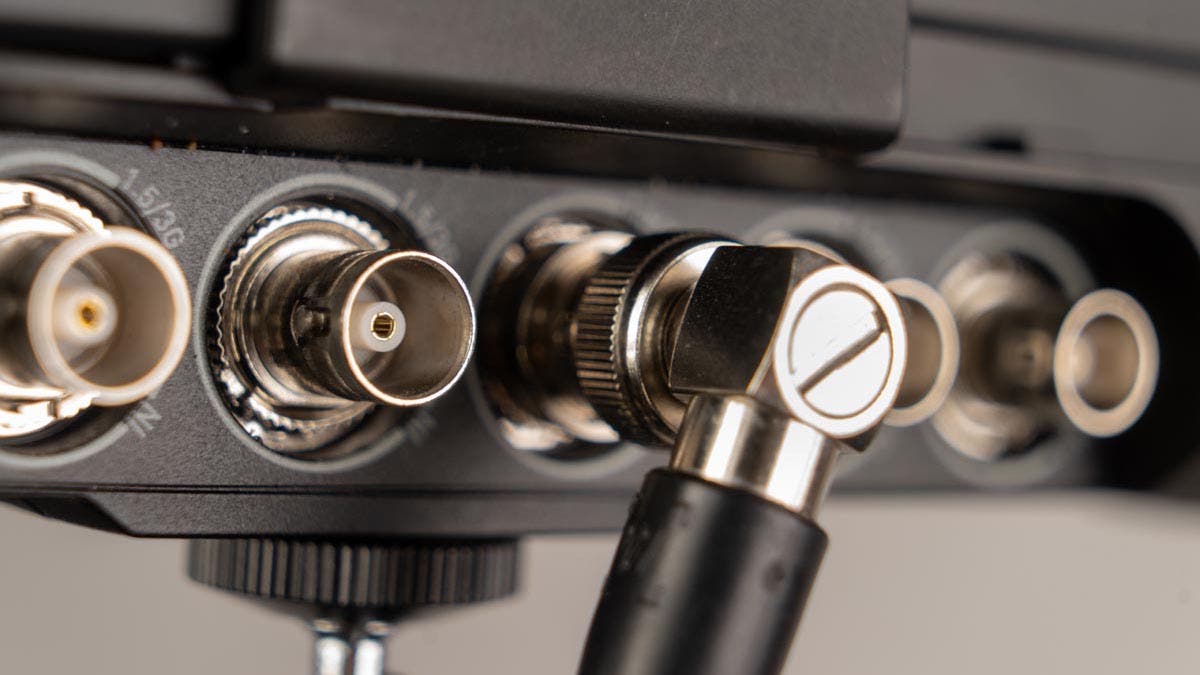

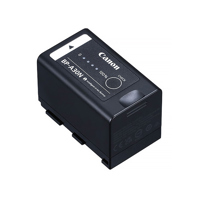
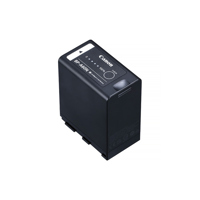
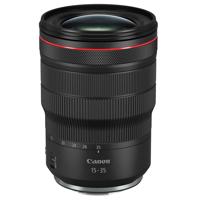
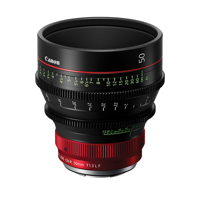
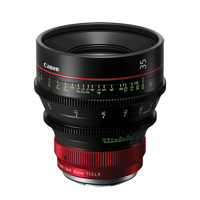
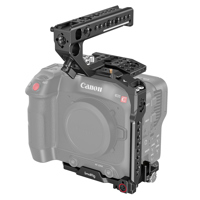

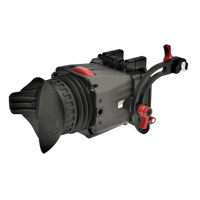
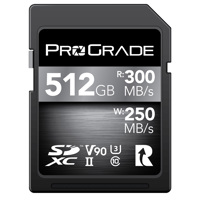
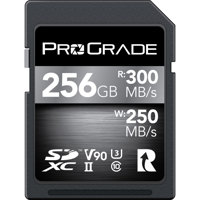
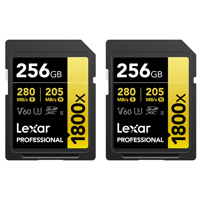
- EOS C80 Cinema Camera -
The EOS C80 camera is designed for limitless creative vision. The compact, full-featured camera body includes Canon's 6K full frame Back-Illuminated Stacked CMOS sensor, Cinema RAW Light and 4K/120p internal recording, Canon's next-generation Dual Pixel CMOS AF II and a 12G-SDI interface. The EOS C80 seamlessly integrates into almost any production providing the ultimate flexibility and outstanding image quality.
6K Full Frame Back-illuminated Stacked CMOS Sensor
The EOS C80 features our 6K back-illuminated stacked full frame CMOS sensor. The sensor offers exceptional low noise, enabling the camera to excel in a wide variety of lighting situations and maximizing the camera's full dynamic range. The new sensor delivers faster read-out speeds than previous EOS sensors and when compared to a front-illuminated CMOS sensor, the new sensor's architecture provides improved sensitivity as it increases light capturing efficiency and improves 4K image quality with 6K oversampling.
Triple Base ISO (800, 3200 and 12,800)
Our full frame 6K back-illuminated stacked sensor offers triple-base ISO, which allows the EOS C80 to deliver stunning imagery in a wide range of lighting conditions. With base ISOs of 800, 3200, and 12,800, you will be able to maximize the full dynamic range of the sensor in brilliantly lit or low-light shooting conditions.
Internal Recording: 6K 30P Cinema RAW Light, XF-AVC, XF-HEVC S and XF-AVC S
The EOS C80 can record up to 6K 30P in Cinema RAW Light.
Other recording options include our standard XF-AVC codec which can record in 10-bit 4:2:2 with oversampling from the 6K sensor, creating rich detail and smooth imagery, at frame rates up to 120P, without the need for cropping the image from the sensor. For slow or fast motion recording, the EOS C80 can support up to 4K 120P and 2K 180.
Two additional recording codecs are now available: XF-AVC S and XF-HEVC S. These formats feature an easy-to-manage naming system and folder structure, while recording in the familiar MP4 format and preserving metadata.
Additionally, the EOS C80 also supports 6K/60P HDMI RAW output.
High-frame Rate Recording With Auto Focus and Subject Detection
When recording in slow and fast motion (Slow & Fast, 4:2:2 10-bit), the EOS C80 enables Dual Pixel AF II for frame rates of 100 and 120fps and Subject Detection for frame rates between 72-120fps.
Dual SD Card Slots
The EOS C80 features two SD Card slots supporting simultaneous recording and a variety of recording modes, such as simultaneous recording for backup or proxy files for editing, simultaneous recording of different formats and resolutions, and relay recording, which is critical for lengthy video shoots. The slots are compatible with SD UHS-II, V90-class cards.
• Dual Slot Recording
• Simultaneous recording of proxy files
• Simultaneous recording of different formats
• Relay recording
Camera-to-Cloud Collaboration
The camera has native compatibility with Frame.io's Camera-to-Cloud (C2C) technology. This feature enables you to send proxy files immediately after recording internally, directly from the camera, for a faster and more secure path from production to post. The efficient proxy files don't require additional processing or conversion, and are available to view, share, and edit remotely between teams in different locations.
Dual Pixel CMOS AF II
The EOS C80 supports the next generation of Canon's acclaimed Dual Pixel CMOS Autofocus, Dual Pixel CMOS AF II. The camera's back-illuminated stacked sensor provides better light-capturing efficiency, widening the area of the sensor that can be used for AF.
EOS iTR AF X (People Detection)
With outstanding speed, precision, and a wide autofocus range, Dual Pixel CMOS AF II uses the EOS Intelligent Tracking and Recognition (iTR AF X) algorithm, developed with deep learning technology, to enable high-performance detection of human beings. In addition to human eyes, face, and head, the camera can detect a human body and follow it with high accuracy.
EOS iTR AF X (Animal Detection)
iTR AF X Animal Detection detects the eyes, face, or the entire body of an animal to enable highly accurate focusing and tracking not affected by subject size or face orientation.
12G-SDI and a Variety of Interfaces
The EOS C80 has a diverse set of interfaces making it a versatile camera for variety of productions. The EOS C80 distinguishes itself with built-in 12G or 3G SDI and a second full-sized BNC output for Time Code, which enable uncompressed video signal transfer with a secure cable connection.
Other interfaces include: two three-pin mini-XLR audio inputs (INPUT 1 and INPUT 2), a Microphone terminal (3.5mm stereo mini-jack), and REMOTE terminal (2.5mm stereo mini-mini), a full-size HDMI interface (HDMI OUT, Type A Terminal).
With the December 2024 firmware upgrade, the EOS C80 gains a 1920x1080P output option while recording internally at higher resolutions.
Ethernet, and Wi-Fi Control
The built-in Ethernet port and Wi-Fi enable Canon's IP-based remote control XC Protocol. XC Protocol maximizes operability and remote control of camera settings. Using the XC Protocol, the camera can be operated by Canon's RC-IP1000 and RC-IP100 controllers (sold separately), and XC Protocol-enabled third-party remote control panels (RCP) can remotely shade the camera.
Additionally, Canon's Remote Control Camera Application (RCCA) can control camera settings as well as multiple cameras. The camera also features SRT protocol, enabling IP streaming of video and audio.
Built-in ND Filters, Improved Body Design, Compact and Lightweight
The EOS C80's compact mechanical ND filter assembly is specifically designed for the RF mount's short flange back. Buttons for direct control of ND filters are located on the right-hand side of the camera.
The EOS C80 provides up to ten stops of ND filtration, allowing users to shoot in various lighting conditions. The use of ND filters allows a camera operator to adjust exposure while maintaining the depth of field.
The RF mount's short flange back allows the EOS C80's body to be small and lightweight, making the camera just as comfortable on a drone or a gimbal as it is on your shoulder, a tripod, or any configuration where compact size and light weight are important.
The camera also has an ergonomic design with a new, lightweight handle assembly, and the Multi-function Shoe is located just above the LCD screen.
Mount Adapter PL-RF with Cooke/i Technology Compatibility
The Mount Adapter PL-RF, new to the RF ecosystem, unlocks a broad assortment of PL mount lenses for Canon's RF cameras. The adapter is compatible with Cooke/i Technology's metadata protocol and includes lock plates to ensure a secure lens mount.
Auto Clear Scan Mode
The Auto Clear Scan setting available in the EOS C80, is an automatic shutter mode setting that can detect the frequency of light sources between 50.0 Hz to 2011.2 Hz to help reduce or virtually eliminate the flickering in some LED walls.
Canon Multi-Camera Control App
The EOS C80 is compatible with the Canon Multi-Camera Control App for iPhone or iPad.
- RF 24-105mm f/2.8 L IS USM Z Lens -
The RF24-105mm F2.8 L IS USM Z is the world's first 24-105mm focal length lens combined with consistent f/2.8 aperture. With its constant f/2.8 max aperture, full-frame coverage, and its ability to zoom past the traditional 70mm roadblock to a true portrait-length 105mm, this lens is an incredible standard zoom solution for many different applications. An optional, dedicated Power Zoom Adapter PZ-E2 transforms the video operation possibilities with its smooth and versatile zooming. Even in low light, this lens will excel for weddings and events, photojournalism, portraiture, studio work, and video creation.
Outstanding Optical Performance with Consistent f/2.8 Maximum Aperture
By taking advantage of the large diameter RF mount and short back focus, the RF24-105mm F2.8 L IS USM Z is able to achieve a maximum aperture of f/2.8 throughout its entire zoom range. This enables you to continuously shoot up to the frequently used 105mm without switching lenses, opening a world of possibilities for both photo and movie shooting.
Supports Optional Canon Power Zoom Adapters
The RF24-105mm F2.8 L IS USM Z crosses the worlds of photography and movies. The optional Power Zoom Adapters PZ-E2 and PZ-E2B enable smooth, high-precision zoom control during movie shooting. Plus, attachment and detaching can be managed without the use of a special tool. The Power Zoom Adapter PZ-E2B comes equipped with a 20-pin port for compatibility with cinema or broadcast lens accessories such as zoom servo grip or focus demand. This lens and Power Zoom Adapter combination makes unassisted single-person video shooting operation easy and within reach.
Eleven Aperture Blades for Rich Bokeh
With eleven aperture blades and a large f/2.8 aperture, the RF24-105mm F2.8 L IS USM Z produces a beautiful, almost circular bokeh effect - even when stopped-down. The wide aperture also allows for faster shutter speeds in low light situations and helps prevent subject blurs.
Iris Ring for Precise Lens Aperture Control
The RF24-105mm F2.8 L IS USM Z is equipped with an iris ring (aperture control), the first among RF lenses. This allows video users to manually control exposure adjustment and the degree of background blur while shooting video, with click-less, smooth operation - similar to the operability in a cinema lens.
800-652-2666